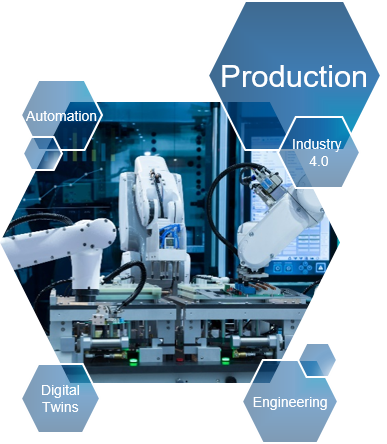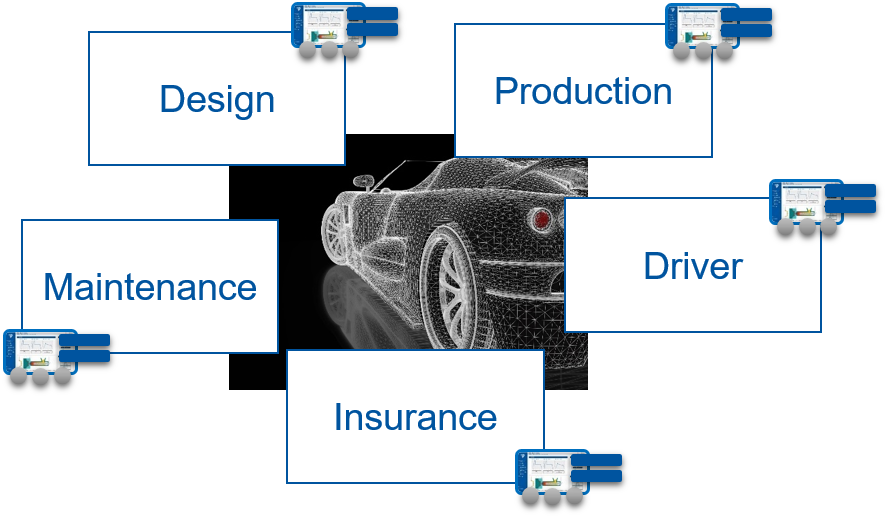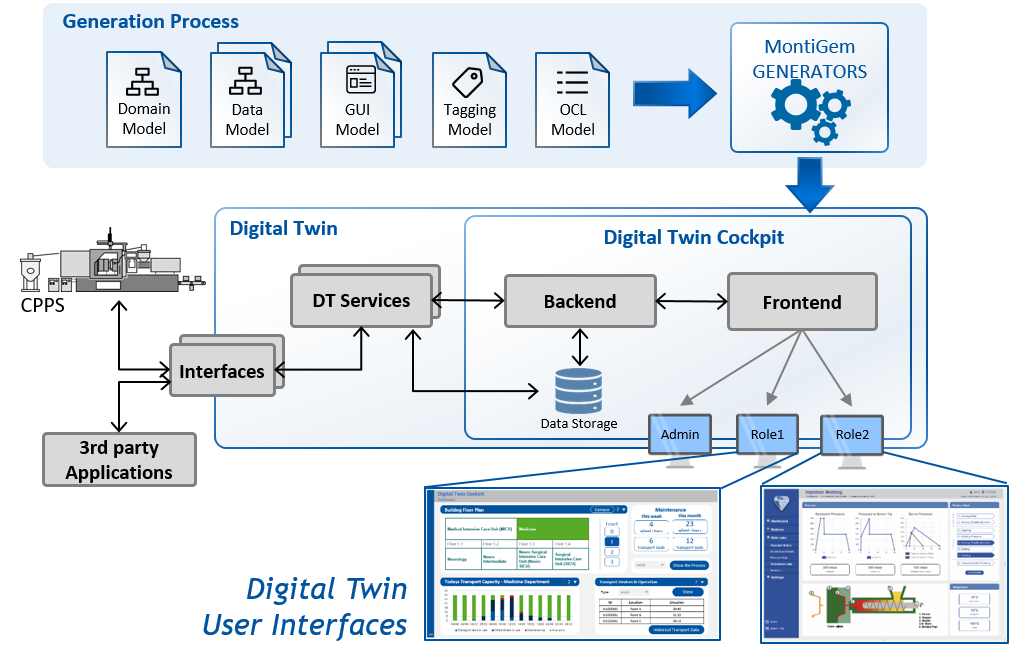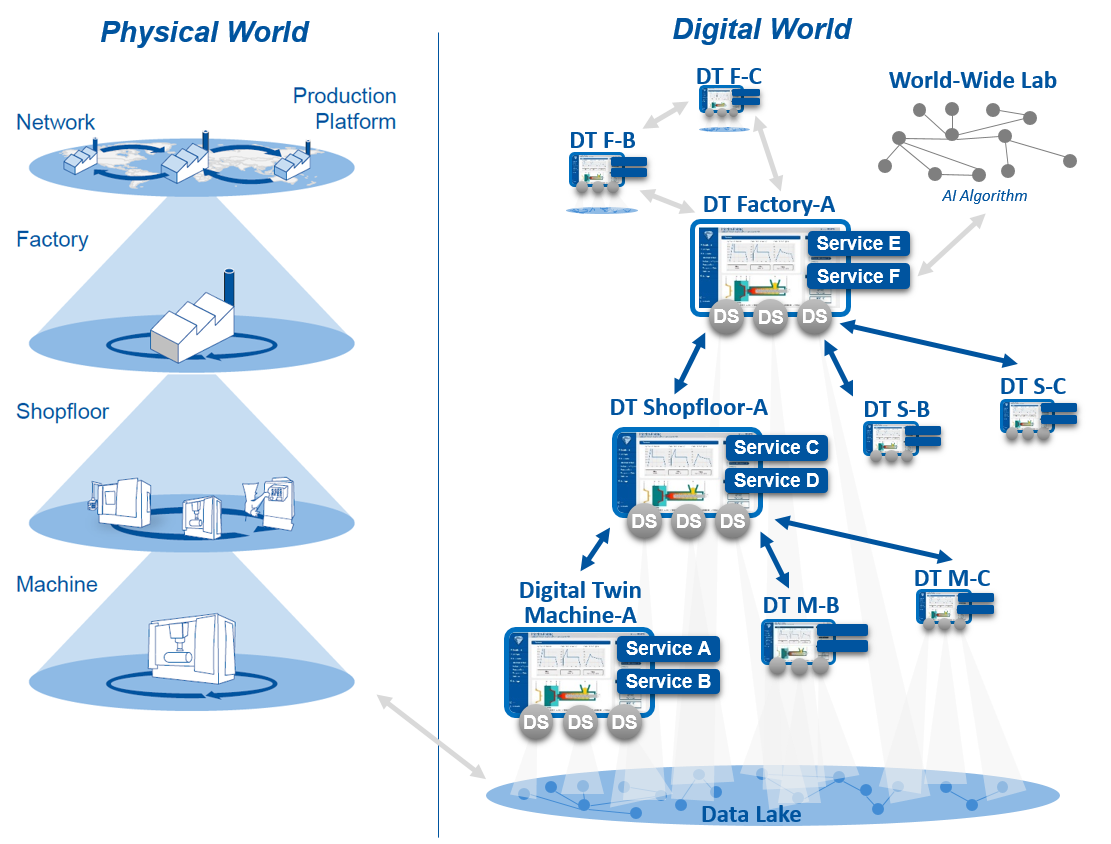Digital Twins and Digital Shadows in Engineering and Production
Summary and Definitions of Most Relevant Topic Papers

There exists a plethora of definitions for Digital Twins (DTs), Although there is a rough convergence, there is little consensus about what a digital twin actually is. The main weaknesses [BMR+22] about the available definitions are that they are:
- ambiguous, by deferring to another undefined term;
- narrow, by focusing on specific use cases, domains, or technologies;
- underspecified, as they fall short on discussing the role of models and additional information, characteristics, and functionalities a DT has over its physical object; or
- utopian, due to all-encompassing aspirations.
As none of the found definitions fit, we have proposed generally and especially in the [BDJ+22] the following definition:
Various definitions of digital twins are in use. Here, we condense these definitions into a more innovative one that not only allows simulations but various other forms of uses. An earlier version of this text is based on [DMR+20], [BMR+22], [BDJ+22], and [BBD+21b]. See also our essay on Digital Twin Definitions.
Definition: Digital Twin, V2.2
A digital twin of an original system is a software that consists of
- a set of models of the system and
- a set of digital shadows, both of which are purposefully updated on a regular basis, and
- provides a set of services to use both purposefully with respect to the original system.
The digital twin interacts with the original system by
- providing useful information about the system’s context and
- sending it control commands.
To be able to create a digital twin requires that we have observable elements in the physical world that can be monitored, sensed, or actuated and controlled.
The set of models helps to understand the system in the physical world, e.g., structure, behavior, physical, geometrical or mathematical models. These models can be, e.g., used to create the digital twin or to compare the current status of the twin with planned states.
Definition: Digital Shadow
A digital shadow includes
- a set of contextual data traces and/or
- their aggregation and abstraction collected concerning a system for a specific purpose with respect to the original system.
(originally published in [BBD+21b])
Within [BBD+21b], we present a conceptual model, give details on each concept and provide an example from the production domain from our work in the RWTH Cluster of Excellence “Internet of Production”. Following this definition, a digital shadow is a passive set of data [BDJ+22] which is an information source about a system’s state and history. The shadows are collected, filtered, and reduced for their purpose in varying forms of abstractions and are purely digital artifacts produced by a (physical) system. We can use, e.g., process mining algorithms for aggregating digital shadows from observed data [BDJ+22]. Moreover, shadows may contain information from different perspectives, e.g., systems (physical and organizations), processes, products, and humans.
The provided services during runtime of the digital twin might include process mining, artificial intelligence, simulation and predictive control services. Process mining techniques [BHK+21] can be used within DTs as services to further improve and adapt the used knowledge. Artificial intelligence services help to realize real-time decisions and explainable AI within decision support helps to reduce human errors in decision making. Services to control the physical object need to send execution commands via APIs to the physical object and are often related to self-adaptiveness [BBD+21a].

Communication between the DT and its’ original system is bidirectional, allowing, e.g., to send various forms of information about the environment or other systems to the physical system. The DT may also send various forms of control commands, from configurations up to hard real-time execution commands, if the overall system is designed to enable this.
With a focus on the digital shadow and their use, we have in [BDR+21] also investigated what the economic implications and new business models of the use of digital twin services will be.
To visualize relevant information, an interface for domain experts is needed, which leads us to the term digital twin cockpit.
Definition: Digital Twin Cockpit
A digital twin cockpit is the user interaction part (UI/GUI) of a digital twin.
It provides the graphical user interface for visualizations of its data organized in digital shadows and models, and the interaction with services of the digital twin, and thus enables humans to access, adapt and add information and monitor and partially control the physical system.
(originally published in [BMR+22])
A cockpit is, by definition, a part of the digital twin, and can be seen both as a special service provided by the digital twin and an integrative front-end component for various specific services that the digital twin provides. A cockpit visualizes various forms of data, which includes, e.g., digital shadows, any form of data received from third-party systems, all kinds of data and commands entered by the humans using the cockpit and models of the physical system or the operation processes of the physical system.

A specific kind of a digital twin cockpits is a Process-Aware Digital Twin Cockpit (PADTC).
Definition: Digital Twin Cockpit
A Process-Aware Digital Twin Cockpit (PADTC) is a digital twin cockpit that additionally provides functionality to handle explicated processes of the physical object and its’ context.
(originally published in [BMR+22])
A PADTC is also a digital twin cockpit but has a stronger focus on processes, which are explicitly defined using appropriate process definition languages. A PADTC knows the allowed processes (in the form of models), the current status of these processes (in the form of status data), and the history of these processes states and executed actions (in the forms of data lakes). Processes describe the steps needed to be carried out by (1) the physical object, (2) the digital twin, or (3) are expected to be executed by the context, which includes humans and other physical objects respectively their digital twins. A process may have several active participants, but not all of those need to be participating in each process definition, which allows various forms of automation of processes. Thus, a process step may be executed automatically by the physical and digital twiins together, or even by one of them only. Data processing, e.g., is digital twin only activity. In addition, it a process step may be executed by physical objects of the neighboring context, may be executed by humans involved, or may be executed by humans together with both twins.
Besides these foundations of digital twins, we have further investigated which DSLs are relevant for the engineering of Digital Twins, self-adaptive digital twin architectures [BBD+21a], how to use Generative Software Engineering for creating digital twin architectures [BDH+20], how to generate interfaces between a cyber-physical system and its DT [KMR+20], how to derive digital twin cockpits [DMR+20] from models using the MontiGem generator, and how to use process prediction within digital twins [BHK+21]. Other research focuses on the creation of low-code platforms for model-driven digital twins [DHM+22] or sustainable digital twin engineering for the production domain.
To realize digital twins and their cockpits is an increasingly complex task that enforces a high degree of automation for creating them. Within [BMR+22], we have presented a low-code development approach that reduces the amount of hand-written code needed and uses process mining techniques to derive PADTCs.

As such digital twins can exist for various domains, perspectives and levels of detail, it is interesting to investigate how to combine such digital twins in systems-of-systems. Integration challenges for digital twin systems-of-systems [MPRW22] include, e.g., the horizontal integration of digital twin parts, the composition of DTs for different perspectives, or how to handle different lifecycle representations of the original system.
Key Statements
- A digital twin of a system consists of a set of models of the system, a set of digital shadows, and provides a set of services to use the data and models purposefully with respect to the original system.
- A digital shadow includes a set of contextual data-traces and/or their aggregation and abstraction collected concerning a system for a specific purpose with respect to the original system.
- To use model-driven methods for the engineering of digital twins reduces the development time and increases reuse.
- To use low-code platforms to create model-driven digital twins allows us to reuse models and fastens the engineering of digital twins.
Selected Topic-Specific Publications
-
[BMR+22]In: Journal of Computer Languages (COLA), Volume 70, Art. 101121, DOI 10.1016/j.cola.2022.101121, Elsevier, Jun. 2022.
-
[DHM+22]In: Journal of Computer Languages (COLA), Volume 70, Art. 101117, Elsevier, Jun. 2022.
-
[MPRW22]In: 10th IEEE/ACM International Workshop on Software Engineering for Systems-of-Systems and Software Ecosystems, pp. 9-12, ACM, May 2022.
-
[BDJ+22]In: Journal ACM Transactions on Internet of Things, Volume 3, pp. 1-32, DOI 10.1145/3502265, ACM, Feb. 2022.
-
[BHK+21]In: Int. Conf. on Model Driven Engineering Languages and Systems Companion (MODELS-C), pp. 182-187, ACM/IEEE, Oct. 2021.
-
[BBD+21b]In: Conceptual Modeling, ER 2021, A. Ghose, J. Horkoff, V. E. Silva Souza, J. Parsons, J. Evermann (Eds.), pp. 271-281, Springer, Oct. 2021.
-
[BDR+21]In: 54th CIRP CMS 2021 - Towards Digitalized Manufacturing 4.0, Elsevier, Sep. 2021.
-
[BBD+21a]In: 2021 International Symposium on Software Engineering for Adaptive and Self-Managing Systems (SEAMS), pp. 156-166, IEEE Computer Society, May 2021.
-
[DMR+20]In: Conceptual Modeling, G. Dobbie, U. Frank, G. Kappel, S. W. Liddle, H. C. Mayr (Eds.), pp. 377-387, Springer International Publishing, Oct. 2020.
-
[KMR+20]In: Proceedings of the 23rd ACM/IEEE International Conference on Model Driven Engineering Languages and Systems, pp. 90-101, ACM, Oct. 2020.
-
[BDH+20]In: International Conference on Advanced Information Systems Engineering (CAiSE’20), S. Dustdar, E. Yu, C. Salinesi, D. Rieu, V. Pant (Eds.), Volume 12127, pp. 85-100, Lecture Notes in Computer Science, Springer International Publishing, Jun. 2020.
Related Topics
- Agile Model-Based Software Engineering
- Cyber Physical Systems (CPS)
- Generative Software Engineering
- MontiCore - Language Workbench
- UML for Programming - UML/P
- Unified Modeling Language (UML)
- Model-Based Assistive Systems
- Models in Enterprise Information System Development
- MontiGem - Generating Enterprise Management Systems
- MontiThings